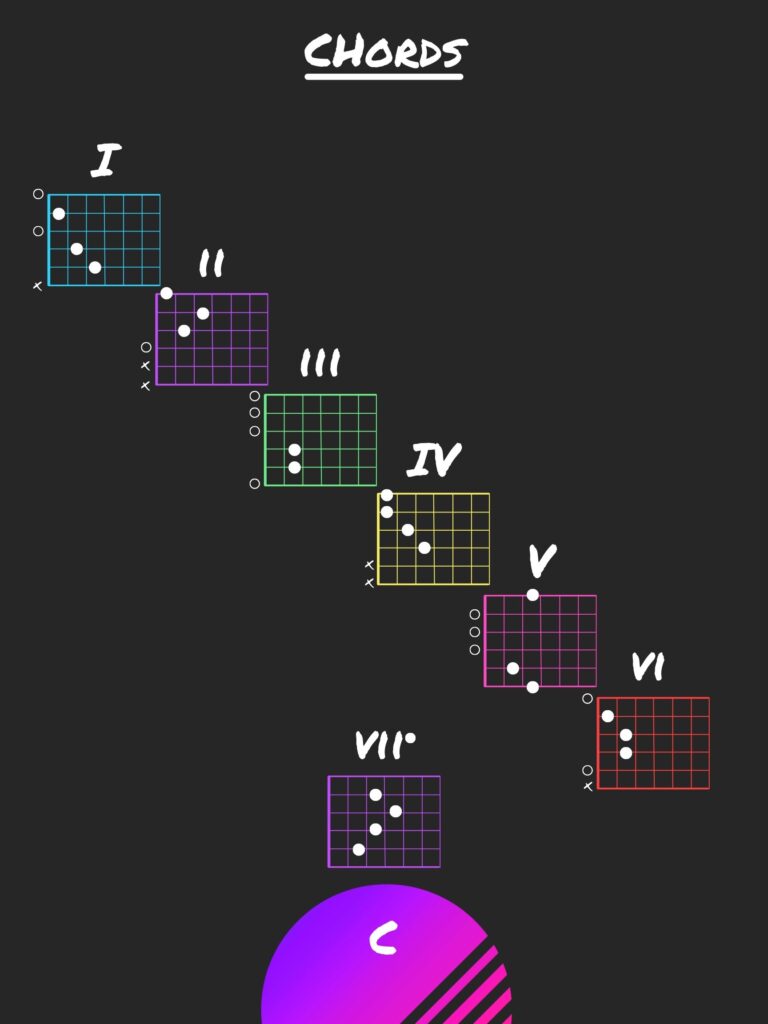If you’re an aspiring guitarist looking to improve your skills and sound, mastering guitar chords is an essential step. And when it comes to playing in the key of C, having a solid foundation of C chords is crucial. In this post, we will explore everything you need to know about chords in the key of C.
Whether you’re a beginner or an intermediate player, this article will provide you with in-depth insights and practical tips to help you navigate the world of chords in the key of C. From basic open chords to triads, these chords are useful to learn on the guitar.
By mastering these chords, you’ll not only be able to strum along to your favorite songs in the key of C but also have a foundation to explore and create your own unique sounds. We’ll also dive into techniques to improve your finger placement, chord transitions, and how to troubleshoot common challenges.
So, grab your guitar and get ready to take your skills to the next level as we delve into mastering guitar chords for C.
The Importance of Mastering Guitar Chords
Mastering guitar chords is an essential skill for any guitarist, regardless of their level of experience. Learning new chords on the guitar is a lifelong pursuit. Chords are the building blocks of songs and understanding how they work will greatly enhance your ability to play and create music. When you have a solid grasp of guitar chords, you can strum along to your favorite songs, write your own music, and even improvise solos.
In the key of C, mastering chords is particularly important. The key of C is one of the most commonly used keys in music, and having a strong foundation in chords will allow you to play a wide variety of songs. Whether you’re playing pop, rock, folk, or even jazz, knowing your chords in the key of C will open up a world of possibilities.
Basic Chord Theory
Before we dive into the specific C chords, let’s take a moment to understand some basic chord theory. Chords are made up of three or more notes played simultaneously. The most common type of chord is a triad, which consists of a root note, a third, and a fifth. In the key of C, the C chord is made up of the notes C, E, and G.
Lets take a look at all the triads in the key of C:
- (I) C Major, C-E-G
- (ii) D Minor, D-F-A
- (iii) E Minor, E-G-B
- (IV) F Major, F-A-C
- (V) G Major, G-B-D
- (Vi) A Minor, A-C-E
- (Vii) B Dim, B-D-F
To play a C chord on the guitar, you’ll typically use a combination of open strings and fretted notes. The most basic C chord is the open C chord, which uses the open strings E, A, D, and G, along with the first fret of the B string. This chord is relatively easy to play and is a great starting point for beginners.
Common Guitar Chords in the Key of C
Now that we understand the basics of chord theory, let’s explore some of the most common guitar chords in the key of C. In addition to the open C chord, there are several other chords that you’ll frequently encounter when playing in this key.
One of the most commonly used chords in the key of C is the G chord. To play a G chord, place your second finger on the third fret of the low E string, your first finger on the second fret of the A string, and your third finger on the third fret of the high E string. Strum all of the strings except for the low E string.
Another important chord in the key of C is the F chord. The F chord is a bit more challenging to play, as it requires you to barre the first fret with your index finger. To play an F chord, place your first finger across all of the strings on the first fret, your second finger on the second fret of the G string, and your third finger on the third fret of the A string. Strum all of the strings except for the low E string.
Below is a chart that demonstrates all of the chords in C.

Techniques for Improving Chord Transitions
Once you’ve learned the basic C chords, the next step is to improve your chord transitions. Smooth and seamless chord changes are essential for creating a polished and professional sound. Here are a few techniques to help you improve your chord transitions.
First, practice transitioning between chords slowly and deliberately. Take the time to ensure that each finger is in the correct position before moving on to the next chord. Focus on accuracy and precision rather than speed. As you become more comfortable with the chord changes, gradually increase your speed.
Second, pay attention to the placement of your fingers. Each finger should be placed as close to the fret as possible, without touching the fret itself.
Developing a chord practice routine will help you learn the chords in the key of C faster. Here is an example of a routine you can start:
Chord Practice Routine
- Warm up, 5 min
- Play C,F, & G back and forth, 10 min
- Play Am, Dm, Em, 10 min
Learning chords in the key of C will open up many opportunities to learn songs and understand the layout of the major scales. Even after years of playing the guitar, Chords in the key of C will be your most essential notes to play.

Download The FretDeck & Chord Secrets Course!
Download Course






